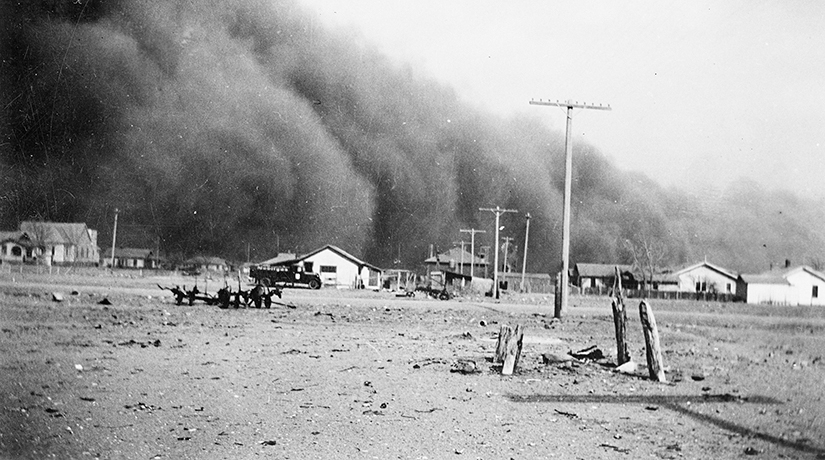In 1862, Congress passed the Homestead Act to encourage farmers in the east to move and farm on land west of the Mississippi River. For a small fee, farmers would get 160 acres of prairie land so long as they lived on it and farmed it for five years. These farmers, known as pioneers, moved out to the prairie in the thousands.
The prairie is located across an enormous swath of land called the Great Plains. The Great Plains have a unique environment. They were once entirely covered in deep-rooted grass that grew between 5 and 10 feet high in some regions. The plains are naturally very windy. It is very hot during the day in the summer and prone to long droughts (when very little rain falls) that can last up to two years.
The pioneers who settled the region cleared away millions of acres of grass. Unfortunately, pioneers didn’t know that clearing away the grasses would create one of the worst man-made environmental disasters in human history.
The Great Plains were a great place to grow grain. The topsoil is the richest and most nutritious part of the soil. Topsoil is the soil in which farmers plant their crops. The thicker the topsoil, the better it is for planting. It is also looser than the soil found underneath. Most topsoil is between 1–8 inches deep, but the topsoil in the Great Plains was 6 feet deep and the richest on earth.
Four generations of farmers—starting with the original pioneers—plowed the Great Plains and used up the topsoil. By 1934, the rain stopped, the topsoil dried out, and the strong winds picked it up. The air was so dry that it was full of static electricity. The dried-out topsoil rose into the air as dust and was carried off by the gusty winds of the Great Plains.
It happened on April 14, 1935. A deep, dark cloud hung over the horizon in Kansas. No one knew what it was nor had any idea what was coming for them—some people thought it was the end of the world. This day became known as Black Sunday. It was the first black blizzard, one of the worst dust storms ever seen in America. It blacked out the sun and covered thousands of miles of land in thick dust from Colorado all the way to New York City. But the lands of the Great Plains were hit the hardest. The thick dust choked and smothered farmers, even indoors.
Winds of 40–60 miles per hour blew the fine dust all across the prairie. The dust was so thick and the winds so strong, that it could take the paint right off of the cars, like sandpaper. It stung your skin, burned your eyes, and clogged your throat. It was so thick that you couldn’t see your hand in front of your face. It destroyed houses and buildings, too. Worst of all, it was impossible to grow anything.
Farmers of the Great Plains began to abandon their farms, packing everything they owned into a car and heading west to look for work. Some farmers stayed, trying to wait out the dust storms.
The Dust Bowl started to end when farmers began to use a new farming technique and after the United States government bought four million acres of prairie and turned it into national grasslands. National grasslands couldn’t be used for farming, which allowed the natural prairie grass to grow back and helped to end the Dust Bowl.
But Americans haven’t learned their lesson from the Dust Bowl. In the 1950s, scientists discovered a water source far underneath the ground of the Great Plains called the Ogallala Aquifer. Farmers could now dig deep into the ground to get water for their crops. They began to plant more crops, including corn to feed pigs and cows for the meat industry. Feed corn requires much more water than wheat.
The Ogallala Aquifer was originally about 100 feet deep. Today, farmers have used so much water that it is only 50 feet deep. In 20 years, it will be dry. Once they lose the water, they won’t be able to farm that land anymore. Could this cause another Dust Bowl catastrophe? Scientists think that it could. The question is, how do we stop it?

